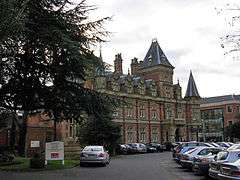Shirley Institute

The Shirley Institute was established in 1920 as the British Cotton Industry Research Association at The Towers in Didsbury, Manchester as a research centre dedicated to cotton production technologies. It was at the Institute that Ventile was invented.[1]
It was funded by the Cotton Board through a statutory levy.[2]
The BCRA merged with the British Rayon Research Association to form the Cotton, Silk, and Man-Made Fibres Research Association in 1961. [3]
Dr Douglas Hill was Director of Research of the BCRA before the merger and led the new organisation. The Director of the BRRA, Leonard Albert Wiseman became Deputy Director. Len Wiseman became Director on Dr Hill's retirement in 1969 and held the post until 1980.
The Shirley Institute developed the tog as an easy-to-follow measure of the thermal resistance of textiles as an alternative to the SI unit of m2K/W.
In 1987–1990 it merged with the Wira Technology Group to form the British Textile Technology Group (BTTG).[4]
See also
- Robert Howson Pickard FRS, director 1937-1943 who expanded the technical facilities extensively in 1936.
References
- ↑ "Technologies of work". Manchester University, Centre for the History of Science, Technology and Medicine. Archived from the original on 2007-11-19. Retrieved 2008-07-10.
- ↑ Textile Council (Dissolution) House of Commons debates, 14 December 1971
- ↑ Hansard, written answers, 9 February 1961
- ↑ "Shirley Institute, Wira Technology merger planned. (Wira Technology Group)". Retrieved 2008-07-10.
External links
Coordinates: 53°24′29″N 2°13′34″W / 53.4081°N 2.2262°W